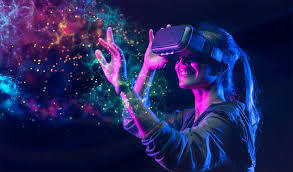Virtual Reality (VR) is an advanced technology that immerses users in a simulated environment, creating a sense of presence and interaction within a virtual world. By leveraging computer-generated environments and sensory inputs such as sight, sound, and sometimes touch, VR offers users a fully immersive and interactive experience that can simulate real-world scenarios or fantastical environments.
The Technology Behind Virtual Reality
VR technology relies on several key components:
- Head-Mounted Display (HMD): A VR headset that delivers visual and sometimes auditory stimuli to immerse users in virtual environments.
- Tracking Sensors: Devices that monitor the user’s head movements and position to adjust the VR environment in real-time, enhancing immersion.
- Input Devices: Controllers or gloves that enable users to interact with objects and navigate within the virtual space.
- Rendering Technology: High-performance graphics processing units (GPUs) and rendering engines that generate realistic visuals and simulate physics within the virtual environment.
Types of Virtual Reality
There are several types of VR experiences based on the level of immersion and interaction:
- Non-Immersive VR: Uses a traditional screen to display 3D images or videos, providing limited interaction.
- Semi-Immersive VR: Involves larger screens or projection systems that surround the user, offering enhanced immersion but with limited interaction.
- Fully Immersive VR: Utilizes HMDs and motion-tracking technology to create a fully immersive experience where users can move and interact within the virtual environment.
Applications of Virtual Reality
Virtual Reality has applications across various industries and sectors:
- Gaming and Entertainment: VR gaming offers immersive experiences, interactive storytelling, and realistic simulations of environments and scenarios.
- Education and Training: VR enables virtual classrooms, interactive learning environments, and realistic simulations for training purposes (e.g., medical training, flight simulations).
- Healthcare: VR is used for therapeutic purposes (e.g., pain management, exposure therapy), surgical simulations, and rehabilitation exercises.
- Architecture and Design: VR facilitates immersive walkthroughs of architectural designs, allowing architects and clients to visualize spaces before construction.
- Tourism and Real Estate: Virtual tours of destinations, hotels, and properties provide potential visitors and buyers with immersive experiences.
Challenges and Considerations in Virtual Reality
Despite its potential, VR faces several challenges:
- Motion Sickness: Some users experience discomfort or motion sickness due to discrepancies between visual and vestibular stimuli.
- Cost: High costs associated with VR hardware (e.g., HMDs, tracking systems) and development can limit widespread adoption.
- Content Development: Creating high-quality VR content requires specialized skills and resources, making content creation challenging and expensive.
- Ethical and Social Implications: Issues such as privacy concerns, addiction, and the impact of prolonged VR use on physical and mental health require careful consideration.
Future Trends in Virtual Reality
Future developments in VR technology include:
- Wireless VR: Advancements in wireless technology will enable untethered VR experiences, enhancing mobility and user comfort.
- Social VR: Integration of social interactions and multiplayer capabilities within VR environments, creating shared experiences and virtual communities.
- Augmented Reality (AR) Integration: Combining VR with AR technology to create mixed reality (MR) experiences that blend virtual and physical worlds seamlessly.
Conclusion
In conclusion, Virtual Reality represents a transformative technology with applications spanning entertainment, education, healthcare, and beyond. As VR technology continues to evolve and become more accessible, its potential to revolutionize how we experience and interact with digital content and the physical world will grow. By addressing challenges and embracing advancements, VR has the power to shape the future of entertainment, communication, learning, and more, offering immersive experiences that were once only imaginable in science fiction.
